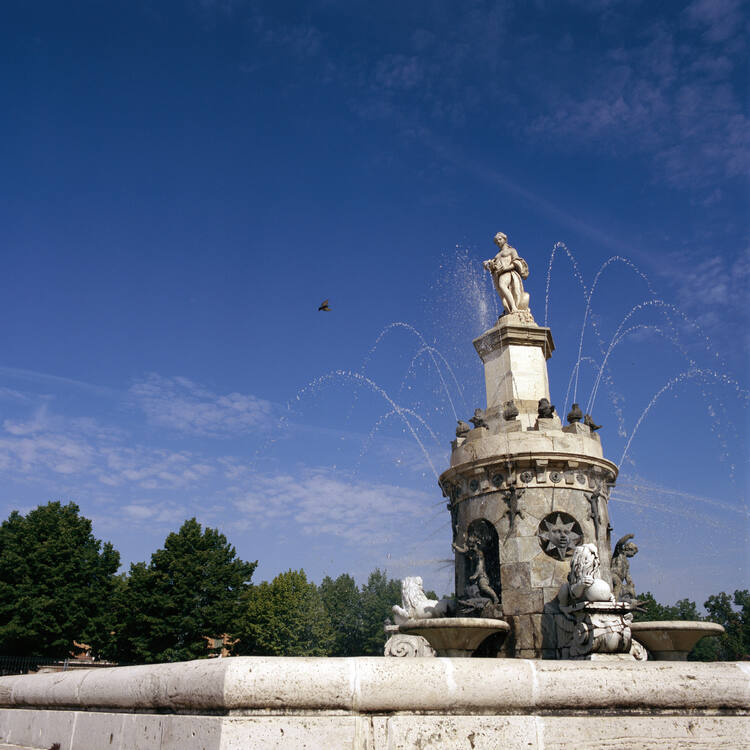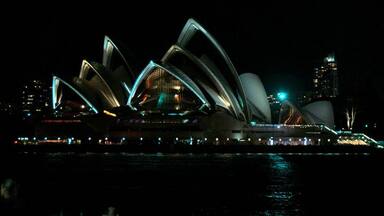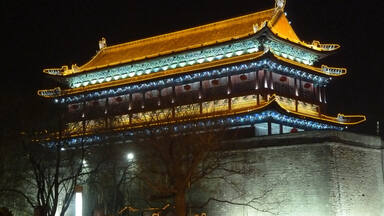Aranjuez Cultural Landscape
Aranjuez Cultural Landscape
The Aranjuez cultural landscape is an entity of complex relationships: between nature and human activity, between sinuous watercourses and geometric landscape design, between the rural and the urban, between forest landscape and the delicately modulated architecture of its palatial buildings. Three hundred years of royal attention to the development and care of this landscape have seen it express an evolution of concepts from humanism and political centralization, to characteristics such as those found in its 18th century French-style Baroque garden, to the urban lifestyle which developed alongside the sciences of plant acclimatization and stock-breeding during the Age of Enlightenment.
Description is available under license CC-BY-SA IGO 3.0
Paysage culturel d’Aranjuez
Avec ses voies d'eau sinueuses qui s'opposent aux lignes droites d'un paysage géométrique, rural et urbain, ses paysages arboricoles et l'architecture délicatement modulée de ses édifices palatiaux, le paysage culturel d'Aranjuez témoigne des relations complexes qui se tissent entre l'homme et la nature. Pendant trois cent ans, la famille royale s'est attachée à développer et à entretenir ce paysage qui a réussi à intégrer les caractéristiques du jardin baroque de style français du XVIIIe siècle mais aussi celles d'un mode de vie urbain allant de pair avec la pratique scientifique de l'acclimatation botanique et de l'élevage au siècle des Lumières. L'apparition de concepts tels que l'humanisme et la centralisation politique ont également influencé à leur façon ce paysage.
Description is available under license CC-BY-SA IGO 3.0
منظر أرانخويث الثقافي
يشكّل منظر أرنخويث الثقافي كتلةً من العلاقات المعقّدة: بين الإنسان والطبيعة، بين مسالك المياه المتعرّجة وتصاميم المناظر الطبيعيّة الهندسيّة، بين المناظر الريفية والحضرية، وبين غابات الأشجار والهندسة منحوتة المعالم لمبانيه الفخمة. وعلى مرّ ثلاثمائة عام من الاهتمام الملكي في تطوّر هذا المنظر الطبيعي ورعايته، تجلّى تطوّر المفاهيم من النواحي الإنسانيّة والمركزيّة السياسيّة إلى الصفات مثل تلك الموجودة في حديقة فرنسيّة الطراز الباروكي التي ترقى إلى القرن الثامن عشر وإلى نمط حياةٍ حضريّ نما إلى جانب خبرات زراعة وعناية النبات وتربية الماشية في خلال عصر الأنوار.
source: UNESCO/CPE
Description is available under license CC-BY-SA IGO 3.0
阿兰胡埃斯文化景观
阿兰胡埃斯文化景观体现了许多复杂的关系,例如人类活动与自然的关系、蜿蜒水道与呈现几何形态的景观设计之间的关系、乡村和城市之间的关系,以及森林环境和当地富丽堂皇的精美建筑之间的关系。300年来,西班牙王室对于阿兰胡埃斯文化景观倾注了许多精力,使得它向世人展示着奇妙的变化。我们不仅能看到人道主义和政治集权的观念,而且可以领略到公元18世纪建造的法国式巴洛克花园所体现出来的特色,以及启蒙运动时期伴随着植物种植和牲畜饲养所发展起来的城市生活方式。
source: UNESCO/CPE
Description is available under license CC-BY-SA IGO 3.0
Культурный ландшафт дворцово-паркового ансамбля Аранхуэс
Этот культурный ландшафт, где в течение 300 лет размещалась королевская резиденция, демонстрирует целый комплекс взаимосвязей: между природой и деятельностью человека, между извилистыми естественными водотоками и геометрически спланированным парковым ландшафтом, между сельской и городской средой, между лесным ландшафтом и тщательно разработанной архитектурой дворцовых зданий.
source: UNESCO/CPE
Description is available under license CC-BY-SA IGO 3.0
Paisaje cultural de Aranjuez
Con sus sinuosos canales y acequias, que contrastan con las líneas rectas del paisaje rural y urbano, sus jardines arbolados y la arquitectura delicadamente modulada de sus edificios palaciales, el paisaje cultural de Aranjuez es un ejemplo de la compleja relación entre el hombre y la naturaleza. A lo largo de trescientos años, los monarcas españoles se dedicaron a diseñar y cuidar este sitio, haciendo de él una muestra de la evolución de los conceptos de humanismo y centralización política, así como un paisaje en el que confluyen las características del jardín barroco francés del siglo XVIII con las del modo de vida urbano propio del Siglo de Luces, en el que también están presentes las prácticas científicas en materia de aclimatación botánica y cría del ganado.
source: UNESCO/CPE
Description is available under license CC-BY-SA IGO 3.0
アランフェスの文化的景観
source: NFUAJ
Cultuurlandschap Aranjuez
Source: unesco.nl
Outstanding Universal Value
Brief synthesis
The Aranjuez Cultural Landscape is a singular entity of complex and historic relationships between nature and human activity, the sinuous watercourses of the rivers and the geometrical design of the landscape, urban and rural life, and between the forest wildlife and the refined architecture. The Tagus and Jarama rivers are the two main arteries of the Aranjuez Cultural Landscape, an extensive area (2,047.56 ha) in the south of the Autonomous Community of Madrid. The surrounding buffer zone is located within the municipal boundaries of Aranjuez (16,604.56 ha).
Aranjuez bears witness to various cultural exchanges over a span of time that had a significant influence in the development of its landmarks and the creation of its landscape, thereby becoming a model for its culture's use of its territory. The process of transformation dates back to the reign of Philip II when, with the influence of the Crown and the wealth of nature as the determining elements, Aranjuez was established as a Real Sitio (Royal Site) in the sixteenth century. The Royal Commands of Ferdinand VI, Charles II, and Isabella II marked its evolution in the 18th and 19th centuries. This landscape survived during the 20th century when it was opened for the enjoyment of the public.
The property comprises diverse elements that make up the different zones: historic vegetable gardens, tree-lined avenues and groves (Legamarejo, Picotajo, El Rebollo), the Palace and ornamental gardens (the Prince’s, the Island, the Parterre, the King’s and Isabella II’s gardens) and the 18th century historic town centre. The conceptual combination of these zones creates a series of landscapes that, together, comprise the Aranjuez Cultural Landscape. These include the water landscape (rivers, ponds, dams and ditches), the agricultural landscape (orchards and nurseries, stock-breeding farms, and meadows), the delectable landscape for leisure (ornamental gardens), the ordered landscape (the geometry of the streets and squares that shape the natural terrain), and the constructed landscape (the palace, the planned town, the roads, and agricultural buildings).
Criterion (ii): Aranjuez represents the coming together of diverse cultural influences to create a cultural landscape that had a formative influence on further developments in this field.
Criterion (iv): The complex designed cultural landscape of Aranjuez, derived from a variety of sources, marks a seminal stage in the development of landscape design.
Integrity
The Aranjuez Cultural Landscape contains all its elements and attributes: the irrigation and hydraulic systems, the vegetable and ornamental gardens, the tree-lined streets and squares, the Royal Palace, and the historic centre.
Both the natural and geometric components of the property as a whole have survived remarkably well, with relatively little loss and effectively no inappropriate intrusion other than modern communication routes. Major buildings as well as the city's layout, its gardens, and tree-lined avenues have been preserved as characteristics of an urban community among orchards and groves, living on a ground plan that mirrors those of ornamental gardens across the river. The 19th-century historic railway, which was the second to be built in Spain, is still maintained.
The measures in place for the conservation of its elements and attributes guarantee the integrity of the property, which is favoured by the fact that most elements are still used for their original purpose. The hydraulic and irrigation systems are still in use. The historic vegetable gardens are still cultivated and the tree-lined streets and squares are conserved and renewed. The ornamental gardens are still visited for leisure and for cultural events. The Royal Palace is used for cultural and institutional acts. The
18th-century town combines its function as a residential centre with the aesthetics and cultural aspects of its urban layout, its architectural features and outstanding buildings.
The conservation of the site is not a contemporary phenomenon but goes back to the patronage of the Spanish Crown. The property confiscations that were carried out in the 19th century and the aggressive development during some years of the 20th century have not had any significant negative effect.
The property is not under any significant threat. There are no natural risks, and the measures taken to address the threats posed by industrial development or demographic growth, including those that might impact its wider setting, guarantee a good state of conservation for all attributes of the property.
Authenticity
The Aranjuez Cultural Landscape is remarkable from a historical, chronological, and spatial viewpoint. From its origins in the 16th century, Aranjuez has been a reflection of the patronage and splendour of the Spanish Crown, personified by two of the most important monarchs in universal history, Charles V and Philip II. Aranjuez has been a convergence of ideas, aesthetics, and science at different times throughout history. It has also been a melting pot of ideas, a reference point and place of influence since its formation.
Although it has lost its role as a royal residence, the property has retained its authenticity to a considerable degree in terms of place and design, architecture, hydrology and to a remarkable extent in function.. Though some of the garden areas require restoration, the overall state of conservation is such that the site is able to demonstrate clearly the stages of its development from the mid-16th to the mid-19th century.
Protection and management requirements
The Aranjuez Cultural Landscape has an adequate system of protection and management with a solid legal base that guarantees and safeguards its singular elements. Aranjuez was declared to be of Historic Value in 1983, a legal measure that guarantees the conservation of the historic centre. The 1996 Town Planning Act provides guidelines for future developments that need to be harmonious and respectful of the conservation of the values of Aranjuez.
The State, regional, and local public administrations oversee its conservation. Notwithstanding the loss of the Crown’s influence on the current development of Aranjuez, some of the elements of the property are administered by Patrimonio Nacional (Spanish National Heritage Board).
The management plan prescribes different management levels for the implementation of the technical part of the plan: regulations, ownership and the responsibilities of each of the institutions that manage the conservation of the site (Aranjuez town council, Autonomous Community of Madrid, and central government).
The property has additional planning tools that are comprehensive and responsive to specific issues such as town planning, traffic, infrastructure development, tourist facilities and the renovation and recovery of buildings and natural landscapes. These plans are supported by corresponding sources of funding and revenue allocation. Monitoring of the property is statistically based on issues such as the impact of traffic or tourism.
Furthermore, the management plan identifies the attributes that comprise the Cultural Landscape and defines provisions on which uses and activities are compatible so as to maintain the integrity and authenticity of the property. In addition, it defines the tools deemed necessary to manage the site efficiently and coherently. It is essential that a management structure, which includes all the entities involved in the supervision and conservation of the Aranjuez Cultural Landscape, is fully operational and that the management systems promote the implementation of the Plan with the participation and agreement of the different stakeholders.
Links
-
Google Arts & Culture: Story
-
World Heritage Journeys web site
-
Ministerio de Educación, Cultura y Deporte (in Spanish)
-
 View photos from OUR PLACE the World Heritage collection
View photos from OUR PLACE the World Heritage collection
-
Ayuntamiento de Aranjuez (Municipality of Aranjuez; Spanish only)
-
Fundacion Paisaje Cultural Aranjuez, Patrimonio de la Humanidad (Spanish only)







